Influence of Microstructure on the Mechanical Properties and Polishing Performance of Large Prehardened Plastic Mold Steel Blocks
Abstract
:1. Introduction
2. Materials and Methods
3. Results
3.1. Characterization and Analysis
3.2. Mechanical Properties
4. Discussion
4.1. Mechanism of Formation of Cross-Sectional Microstructure Features
4.2. Polishing Removal Mechanism
5. Conclusions
- From our examination of a 1.2738 steel bloom, we found that tempered sorbite only occurred close to the surface, with its content steeply decreasing with depth. Tempered bainite was the prevalent constituent of the bloom. Pearlite gradually appeared at larger depths, and pearlite + tempered bainite was the main constituent in the core. Abnormal upper bainite microstructures and coarse carbides were also found in the steel bloom.
- The hardness values varied between 37.4 and 39.3 HRC throughout most bloom sections with the exception of a small core region. The hardness in the core was approximately 36.5 HRC due to the existence of pearlite.
- The polishing performance was strongly affected by the microstructure type. The best polishing performance was found for tempered sorbite, which occurred due to its fine and uniform microstructure. The polishing performance of the tempered bainite + pearlite microstructure, which contained large carbide particles and mixed microstructure, was worse than that of tempered sorbite. This was due to the inhomogeneity of these microstructures and the inhomogeneous deformation of polishing caused by the differences in the microstructure types.
Author Contributions
Funding
Data Availability Statement
Conflicts of Interest
References
- (PDF) Fatigue Behavior of Homogeneous-Microstructure and Mixed-Microstructure Steels (researchgate.net).
- Firrao, D.; Matteis, P.; Spena, P.R.; Gerosa, R. Influence of the Microstructure on Fatigue and Fracture Toughness Properties of Large Heat-treated Mold Steels. Mater. Sci. Eng. A 2013, 559, 371–383. [Google Scholar] [CrossRef]
- Beaudet, F.; Blais, C.; Lehuy, H.; Voyzelle, B.; L’Espérance, G.; Masse, J.P.; Krishnadev, M. Improvement of hardenability and static mechanical properties of P20 + 0.5Ni mold steel through additions of vanadium and boron. ISIJ Int. 2012, 52, 424–433. [Google Scholar] [CrossRef]
- Meng, Y.T.; Cheng, A.H.; Wang, W.H.; Hsu, Y.F. Comparison of microstructure and mechanical behavior of lower bainite and tempered martensite in JIS SK5 steel. Mater. Chem. Phys. 2007, 107, 418–425. [Google Scholar] [CrossRef]
- Hoseiny, H.; Klement, U.; Sotskovszki, P.; Andersson, J. Comparison of the Microstructures in Continuous-cooled and Quench-tempered Pre-hardened Mould Steels. Mater. Des. 2011, 32, 21–28. [Google Scholar] [CrossRef]
- Min, Y.A.; Zhou, Q.; Luo, Y.; Li, D.; Wu, X.C. Tempering Process to Improve Hardness Uniformity of Plastic Mould Steel. J. Iron Steel Res. Int. 2012, 19, 53–58. [Google Scholar] [CrossRef]
- Saeidi, N.; Ekrami, A. Comparison of mechanical properties of martensite/ferrite and bainite/ferrite dual phase 4340 steels. Mater. Sci. Eng. A 2009, 523, 125–129. [Google Scholar] [CrossRef]
- Zhang, Z.; Wu, X.C.; Zhou, Q.; Duan, L.L. Effect of microstructure on the impact toughness of a bainitic steel bloom for large plastic molds. Int. J. Miner. Metall. Mater. 2015, 22, 842–850. [Google Scholar] [CrossRef]
- Shiou, F.J.; Cheng, C.H. Ultra-precision Surface Finish of NAK80 Mould Tool Steel Using Sequential Ball Burnishing and Ball Polishing Processes. J. Mater. Process. Technol. 2008, 201, 554–559. [Google Scholar] [CrossRef]
- Jiang, X.S. Special Steel Microstructure Map; China Machine Press, Inc.: Beijing, China, 2002; ISBN 9787111111252. [Google Scholar]
- Müller, M.; Britz, D.; Ulrich, L.; Staudt, T.; Mücklich, F. Classification of Bainitic Structures Using Textural Parameters and Machine Learning Techniques. Metals 2020, 10, 630. [Google Scholar] [CrossRef]
- Ponomareva, M.; Gervasyev, M.; Romanova, K. Magnetometric research of bainite transformation in Cr-Ni-Mo steels. Mater. Today Proc. 2021, 38, 1879–1881. [Google Scholar] [CrossRef]
- Trofimov, E.; Moghaddam, A.O.; Litvinyuk, K.; Mikhailov, K. Microsegregation in high-entropy intermetallic compounds. J. Alloys Compd. 2023, 934, 168021. [Google Scholar] [CrossRef]
- Sun, J.; Lu, S.P. Influence of inter-dendritic segregation on the precipitation behaviour and mechanical properties in a vanadium-containing Fe–Cr–Ni–Mo weld metal. Scr. Mater. 2020, 186, 174–179. [Google Scholar] [CrossRef]
- Breumier, S.; Ostormujof, T.M.; Frincu, B.; Gey, N.; Couturier, A.; Loukachenko, N.; Aba-perea, P.E.; Germain, L. Leveraging EBSD data by deep learning for bainite, ferrite and martensite segmentation. Mater. Charact. 2022, 186, 111805. [Google Scholar] [CrossRef]
- Zhu, W.T.; Liu, W.S.; Ma, Y.Z.; Meng, S.R.; Wang, J.N.; Duan, Y.T.; Cai, Q.S. Influence of microstructure on crack initiation and propagation behavior in swaged tungsten heavy alloy during Charpy impact process. Mater. Sci. Eng. A 2023, 862, 144219. [Google Scholar] [CrossRef]
- Zhao, P.B.; Shi, Y. Composite Adaptive Control of Belt Polishing Force for Aero-engine Blade. Chin. J. Mech. Eng. 2013, 26, 988. [Google Scholar] [CrossRef]
- Pashechko, M.I.; Lenik, K.S. Segregation of atoms of the eutectic alloys Fe–Mn–C–B–Si–Ni–Cr at friction wear. Wear 2009, 267, 1301–1304. [Google Scholar] [CrossRef]
- Moneta, M.; Stodolny, J.; Michalkiewicz, B.; Wrobel, J.R. Influence of Surface Roughness on the Properties of Nitrided Layer on 42CrMo4 Steel. Materials 2023, 16, 4496. [Google Scholar] [CrossRef] [PubMed]
- Wang, Y.W.; Guo, Q.; Kang, A.J.; Ma, D.S.; Dong, H. Effect of different microstructures on polishing performance of 3Cr2MnNiMo Steel. J. Iron Steel Res. 2011, 23, 24–28. [Google Scholar] [CrossRef]
- Bertolo, V.; Vilasi, L.; Jiang, Q.; Riemslag, T.; Scott, S.; Walters, C.L.; Sietsma, J.; Popovich, V. Grain refinement by rapid cyclic heating and its effect on cleavage fracture behaviour of an S690 high strength steel. J. Mater. Res. Technol. 2023, 23, 1919–1933. [Google Scholar] [CrossRef]
- Jo, H.H.; Kin, K.W.; Park, H.K.; Moon, J.; Kim, Y.W.; Shim, H.B.; Lee, C.H. Estimation of Cooling Rate of High-Strength Thick Plate Steel during Water Quenching Based on a Dilatometric Experiment. Materials 2023, 16, 4792. [Google Scholar] [CrossRef]
- Jeong, C.G.; Trang, T.T.T.; Woo, Y.Y.; Yoon, E.Y.; Lee, Y.S.; Heo, Y.U. Effect of cooling rate on the final microstructure and tensile property in an Fe–Mn–Si–C-based multiphase TRIP steel. Mater. Sci. Eng. A 2023, 887, 145696. [Google Scholar] [CrossRef]
- Liu, J.H.; Chi, H.X.; Cao, J.C.; Gao, H.Y.; Ma, D.S.; Zhou, J. Effect of cooling rate on microstructure and properties of new high hardness pre-hardening plastic mould steel. Trans. Mater. Heat Treat. 2019, 40, 103–109. [Google Scholar] [CrossRef]
- Gustavo, S.S.; Joaquín, F.B.; Lauralice, C.F.C.; Rosamel, M.M.R.; Rafael, A.M.; George, E.T.; Antonio, C.C. Modeling quenching performance by the kuyucak method. Mater. Sci. Eng. A 2007, 459, 383–389. [Google Scholar] [CrossRef]
- Shah, N.; Deepu, M.J.; Rahul, M.R.; Gandham, P. Microstructure prediction of eutectic high entropy alloy using physical and computer simulation for additive manufacturing condition. J. Alloys Compd. 2022, 929, 167268. [Google Scholar] [CrossRef]
- Bowden, F.P.; Tabor, D. The Friction and Lubrication of Solids, Part II; Clarendon Press: Oxford, UK, 1964; ISBN 9780198507772. [Google Scholar]
- Zhao, Z.D.; Xu, H.M.; Zhang, Z.H.; Jia, Y.X.; Wang, L.J. Approach of mechaincal model on frictional mechanism in metal sheet plastic deformation. J. Plast. Eng. 2003, 1, 52–56. Available online: https://sxgc.cbpt.cnki.net/WKC3/WebPublication/paperDigest.aspx?paperID=6064bc34-426f-4c16-9a6a-7594259d5fc3 (accessed on 21 January 2002).
- Tsai, M.J.; Huang, J.F.; Kao, W.L. Robotic polishing of precision molds with uniform material removal control. Int. J. Mach. Tool Manuf. 2009, 49, 885–895. [Google Scholar] [CrossRef]
- Ghosh, S.; Patnamsetty, M.; Somani, M.C.; Peura, P. Characteristics of dynamic softening during high temperature deformation of CoCrFeMnNi high-entropy alloy and its correlation with the evolving microstructure and micro-texture. J. Mater. Res. Technol. 2021, 15, 6608–6623. [Google Scholar] [CrossRef]
- Wang, Y.; Chen, X.; Zuo, P.P.; Wu, X.C. Influence of copper and sulfur on the cutting performance of P20-type plastic mold steel. Mater. Rep. 2022, 10, 173–179. [Google Scholar] [CrossRef]


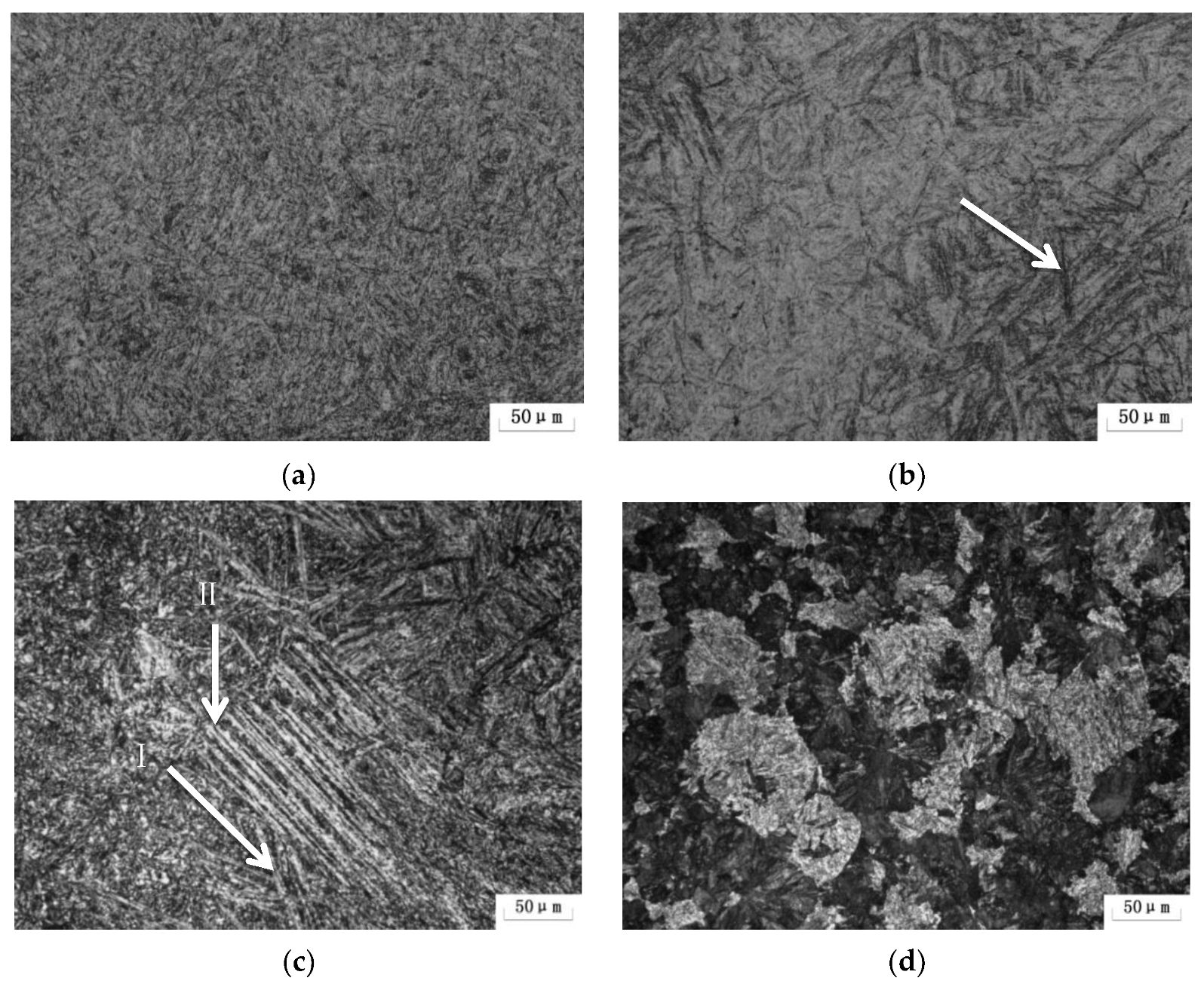

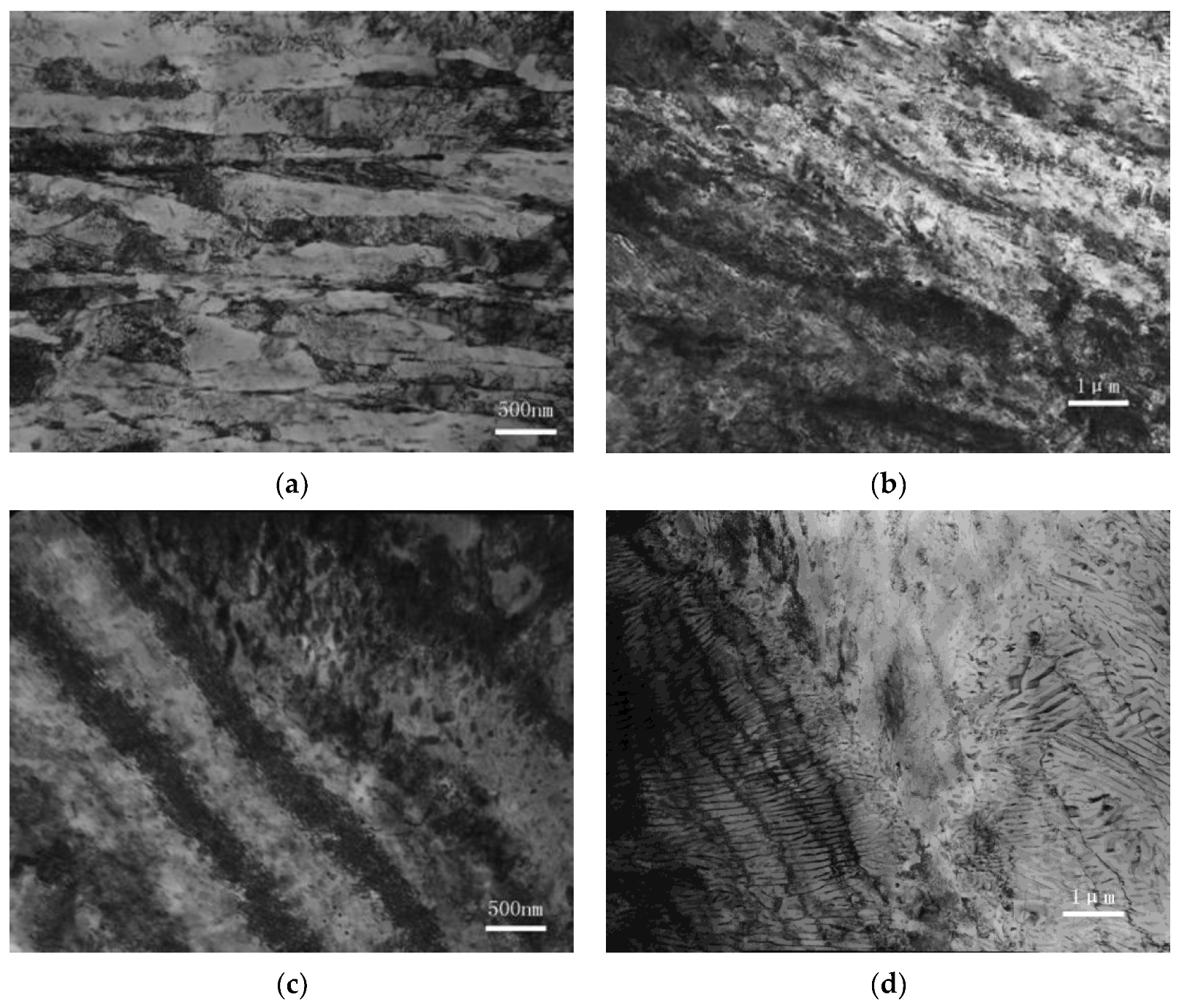
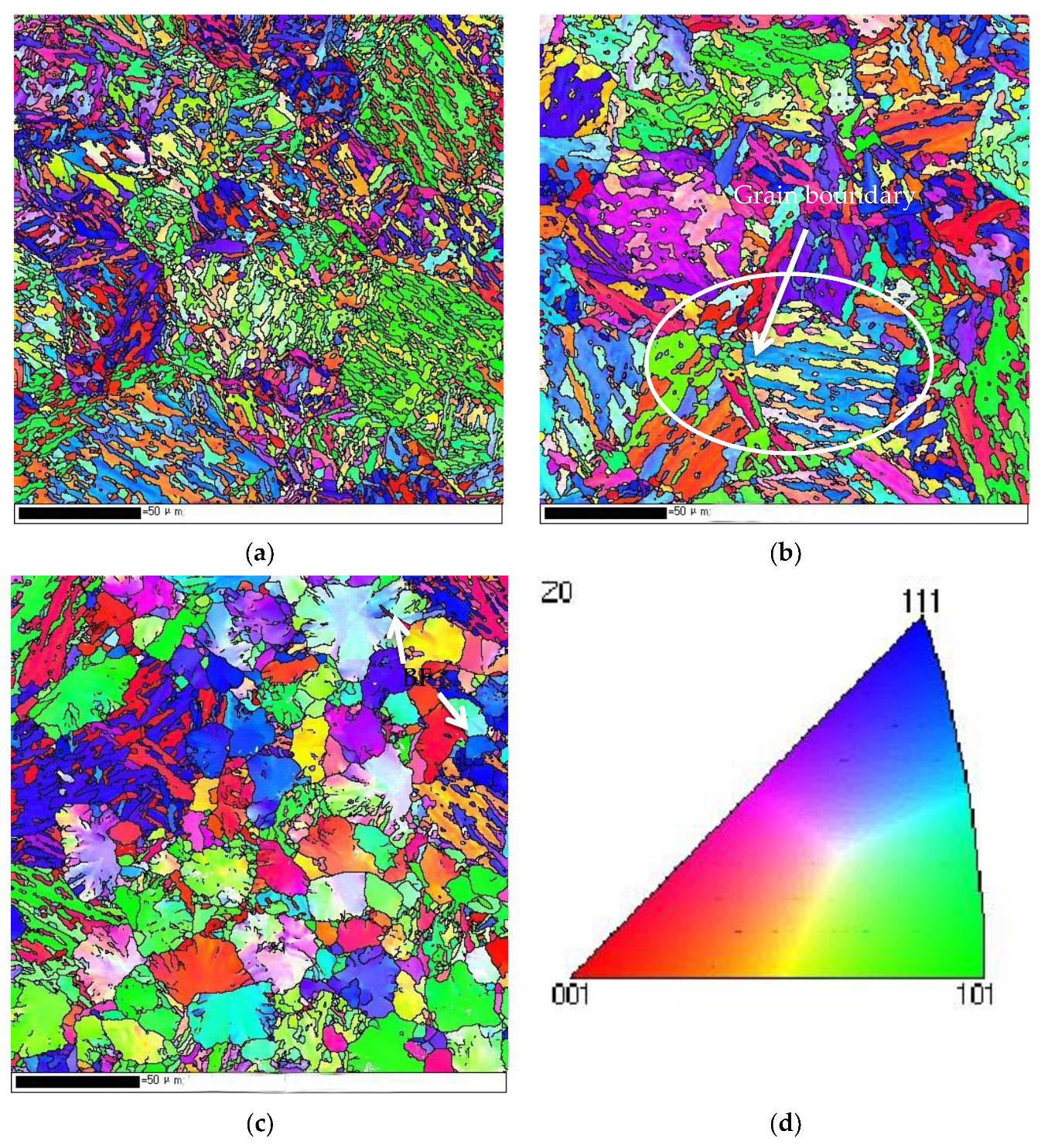
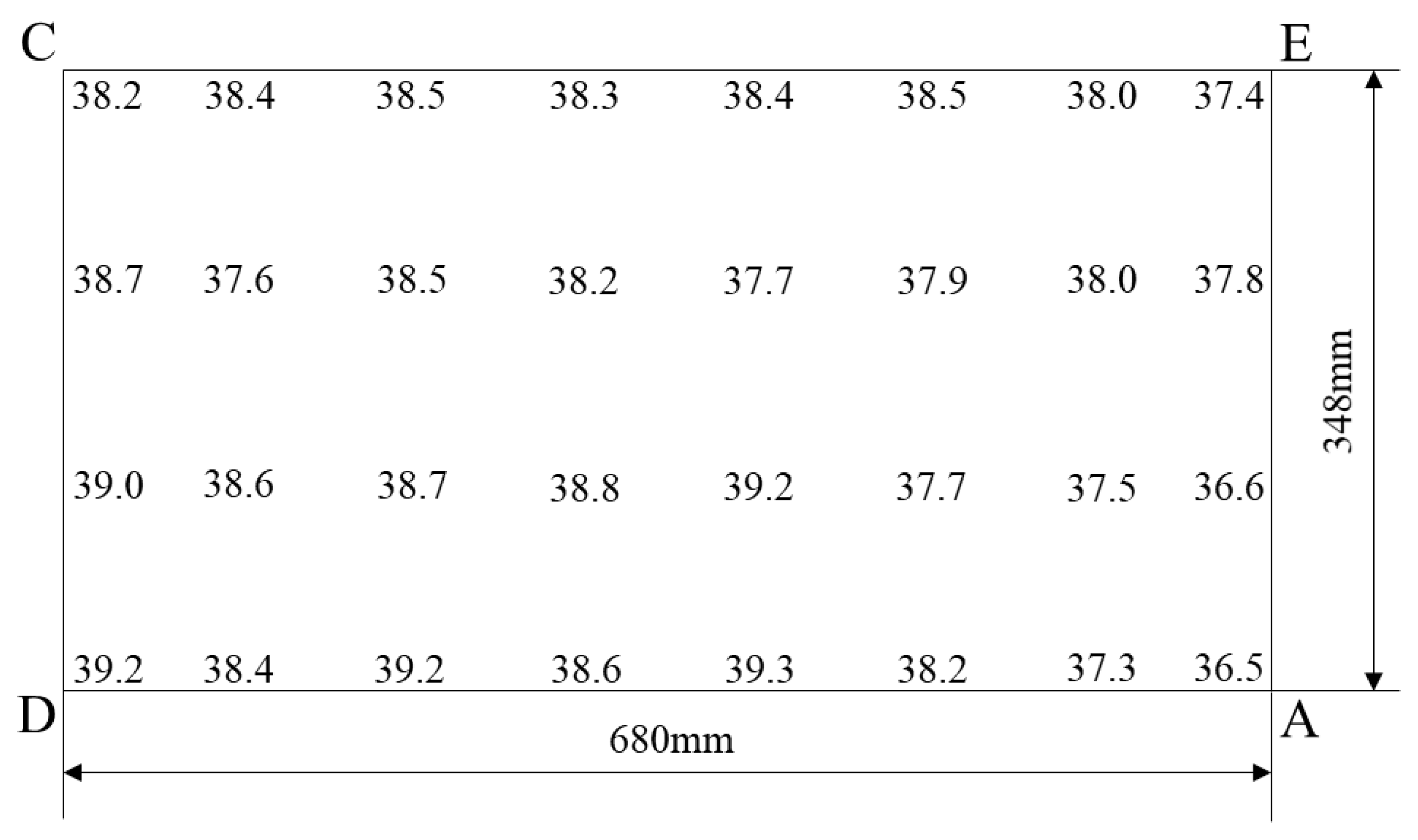
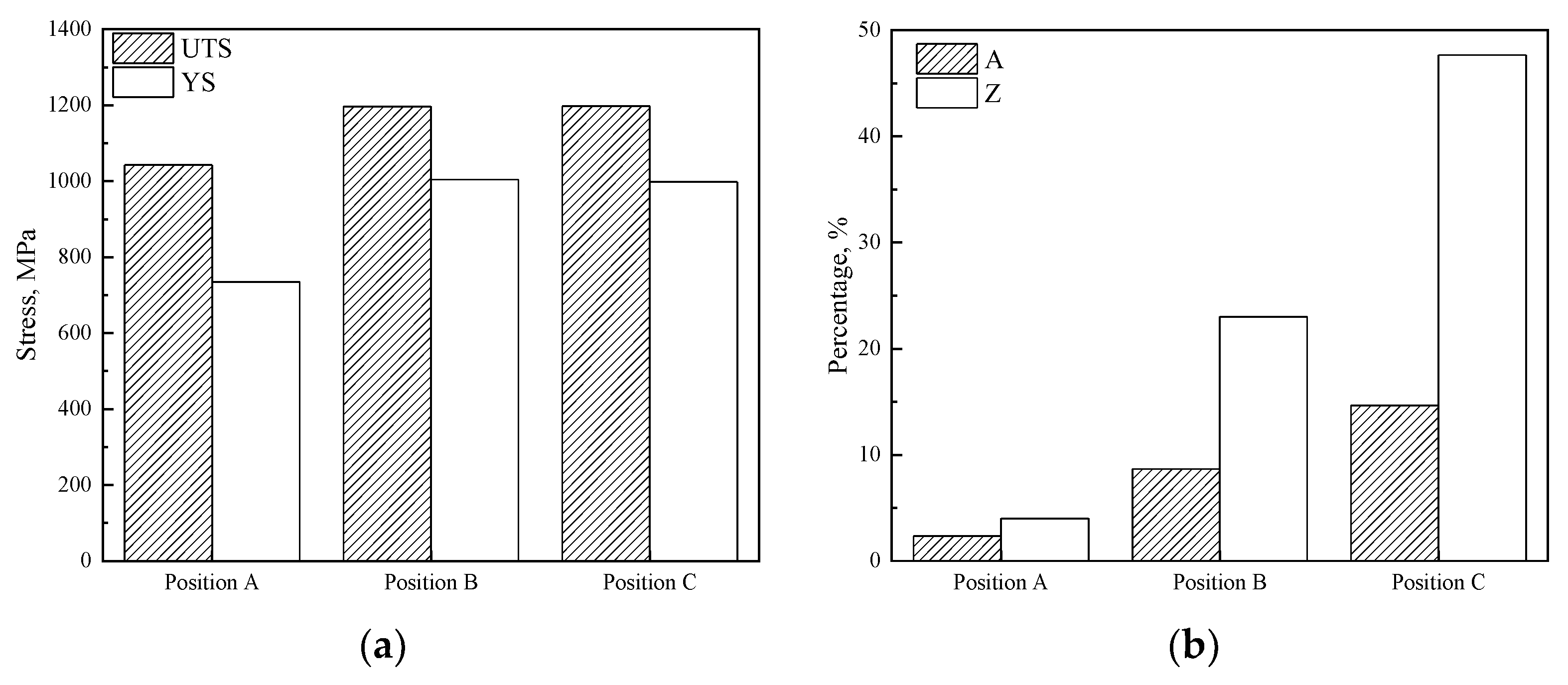
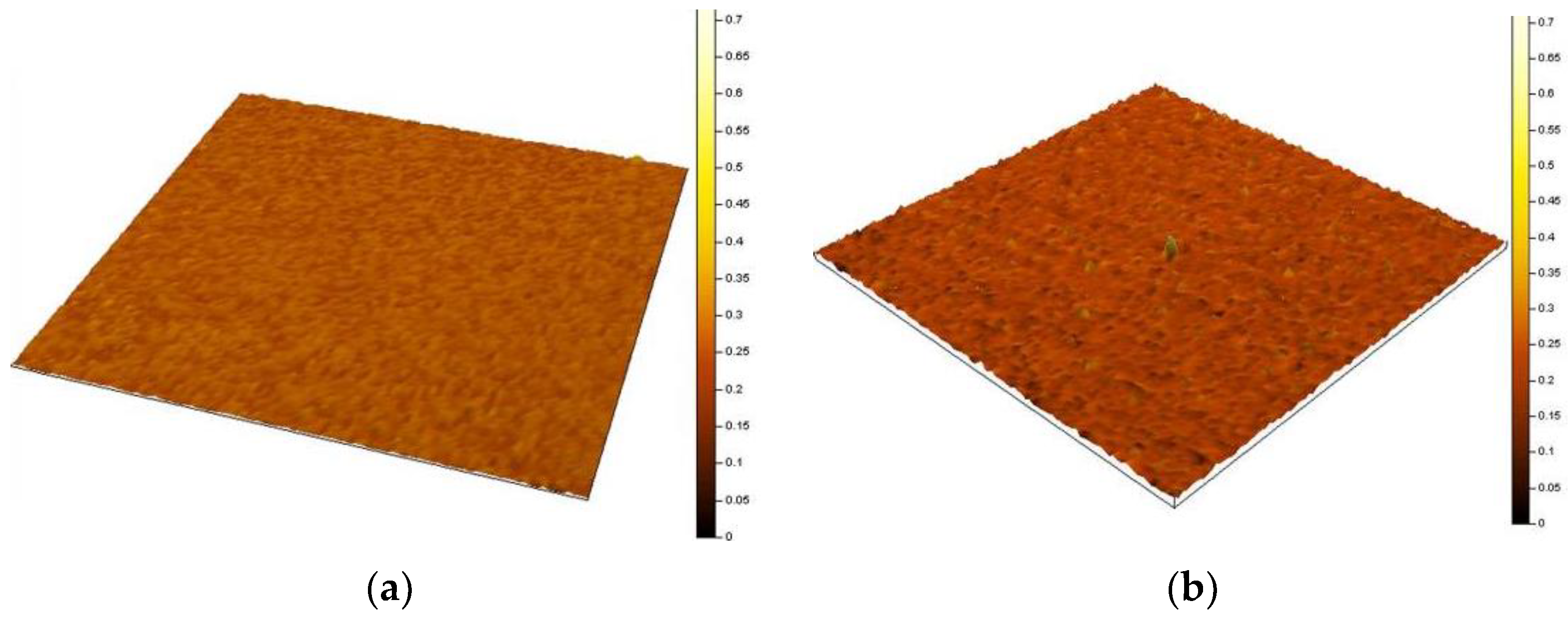
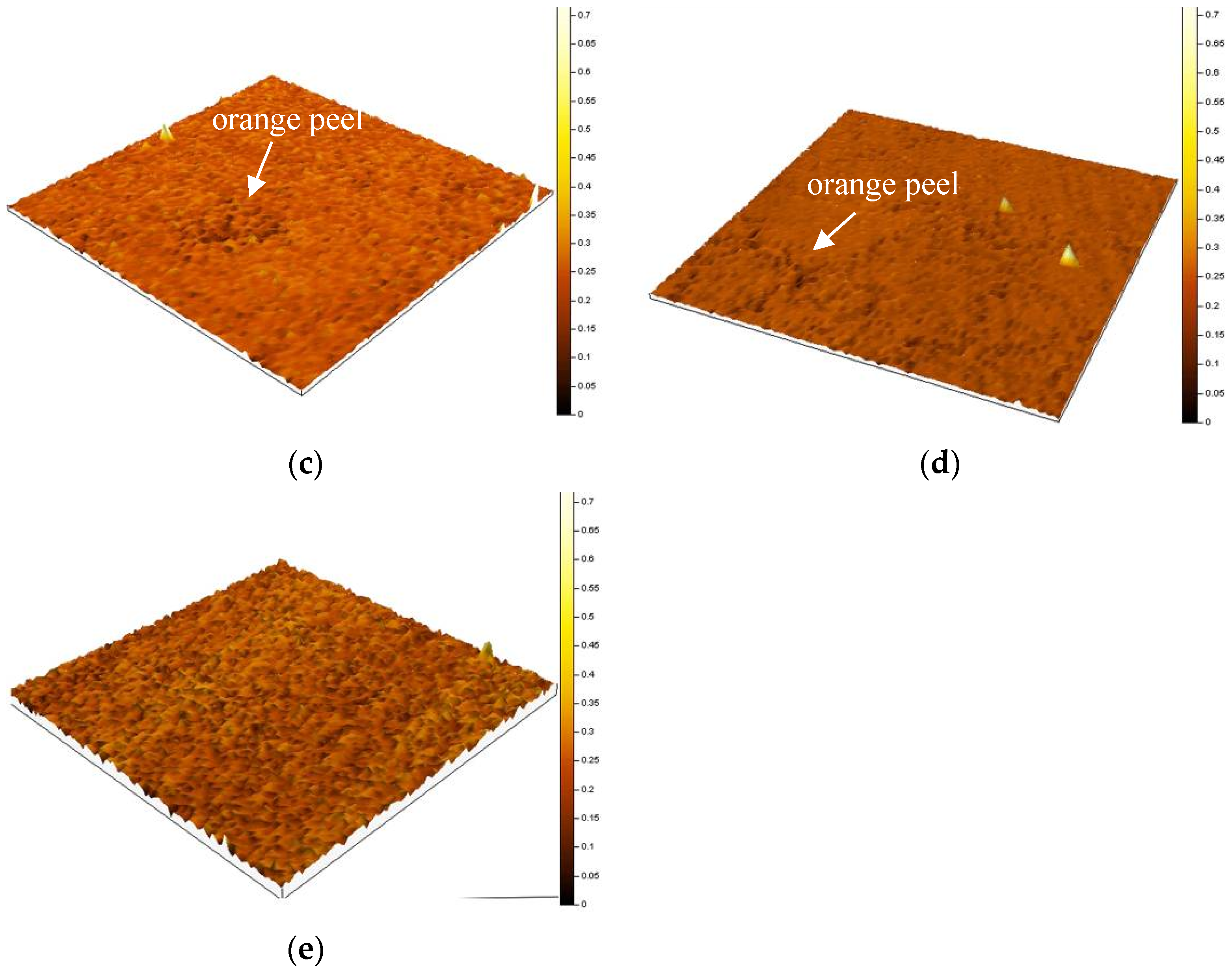
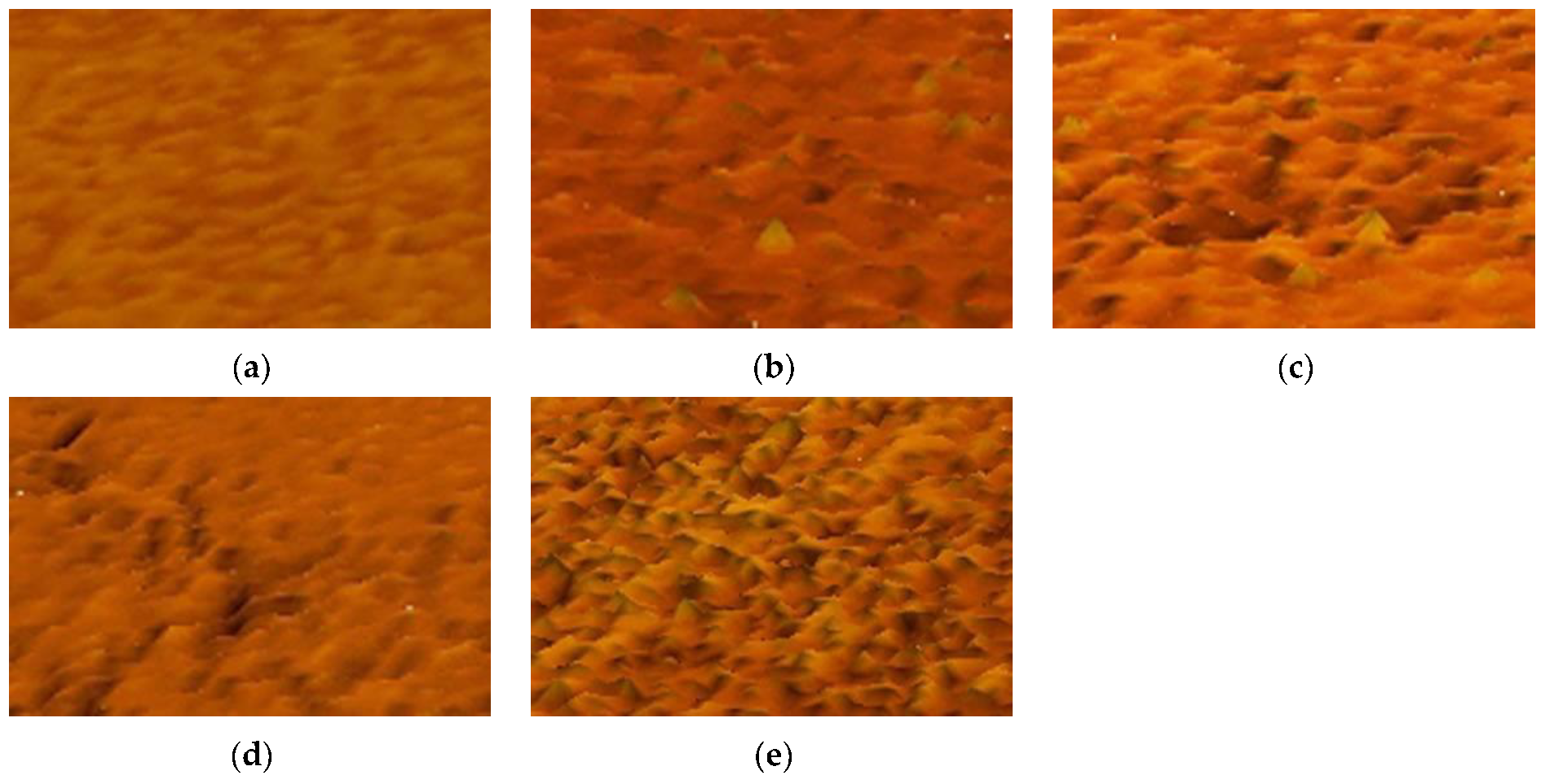
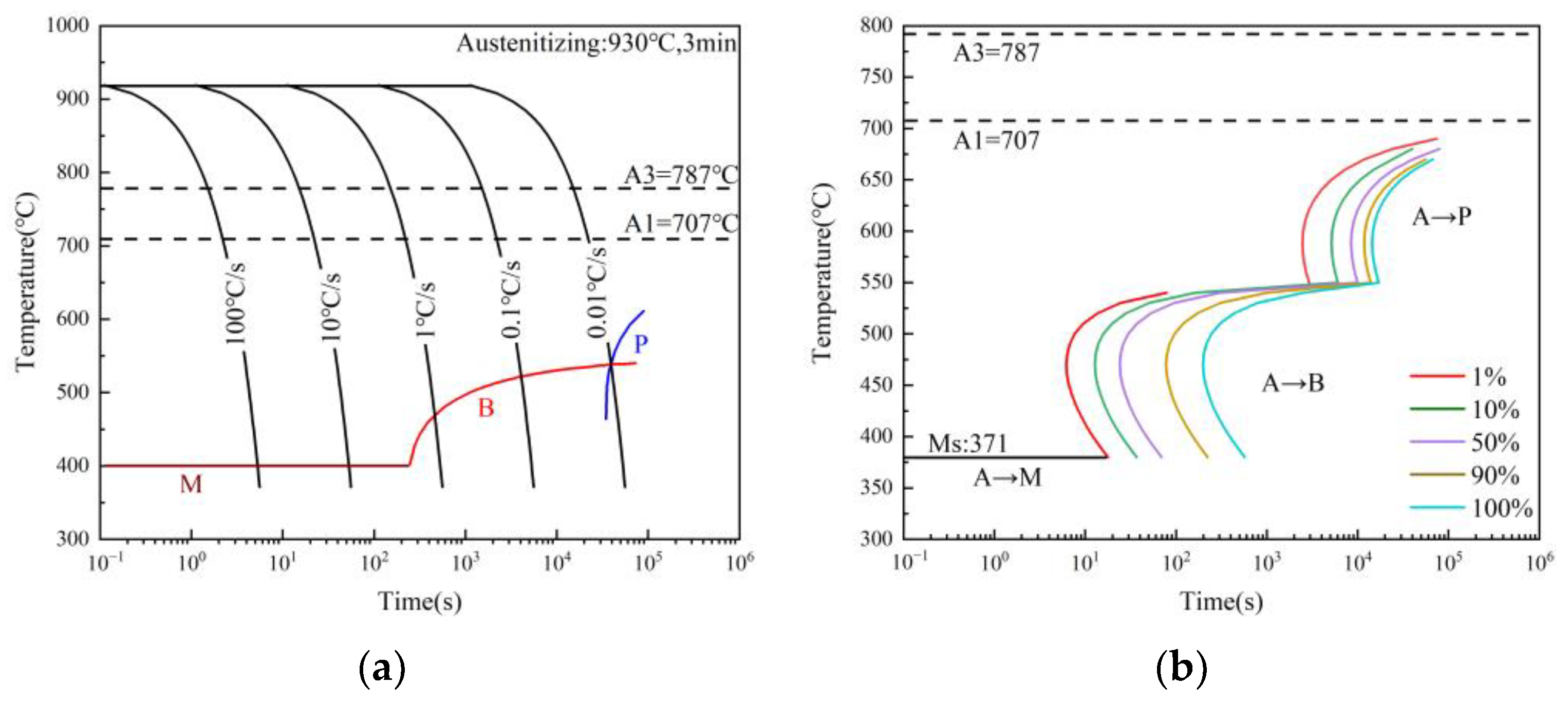
| Steel | C | Si | Mn | P | S | Cr | Ni | Mo | Fe |
|---|---|---|---|---|---|---|---|---|---|
| 1.2738 | 0.40 | 0.43 | 1.40 | 0.0081 | 0.0023 | 1.92 | 1.05 | 0.31 | Bal. |
Disclaimer/Publisher’s Note: The statements, opinions and data contained in all publications are solely those of the individual author(s) and contributor(s) and not of MDPI and/or the editor(s). MDPI and/or the editor(s) disclaim responsibility for any injury to people or property resulting from any ideas, methods, instructions or products referred to in the content. |
© 2024 by the authors. Licensee MDPI, Basel, Switzerland. This article is an open access article distributed under the terms and conditions of the Creative Commons Attribution (CC BY) license (https://creativecommons.org/licenses/by/4.0/).
Share and Cite
Chi, H.; Liu, J.; Zhou, J.; Ma, D.; Gu, J. Influence of Microstructure on the Mechanical Properties and Polishing Performance of Large Prehardened Plastic Mold Steel Blocks. Metals 2024, 14, 477. https://doi.org/10.3390/met14040477
Chi H, Liu J, Zhou J, Ma D, Gu J. Influence of Microstructure on the Mechanical Properties and Polishing Performance of Large Prehardened Plastic Mold Steel Blocks. Metals. 2024; 14(4):477. https://doi.org/10.3390/met14040477
Chicago/Turabian StyleChi, Hongxiao, Jihao Liu, Jian Zhou, Dangshen Ma, and Jinbo Gu. 2024. "Influence of Microstructure on the Mechanical Properties and Polishing Performance of Large Prehardened Plastic Mold Steel Blocks" Metals 14, no. 4: 477. https://doi.org/10.3390/met14040477





